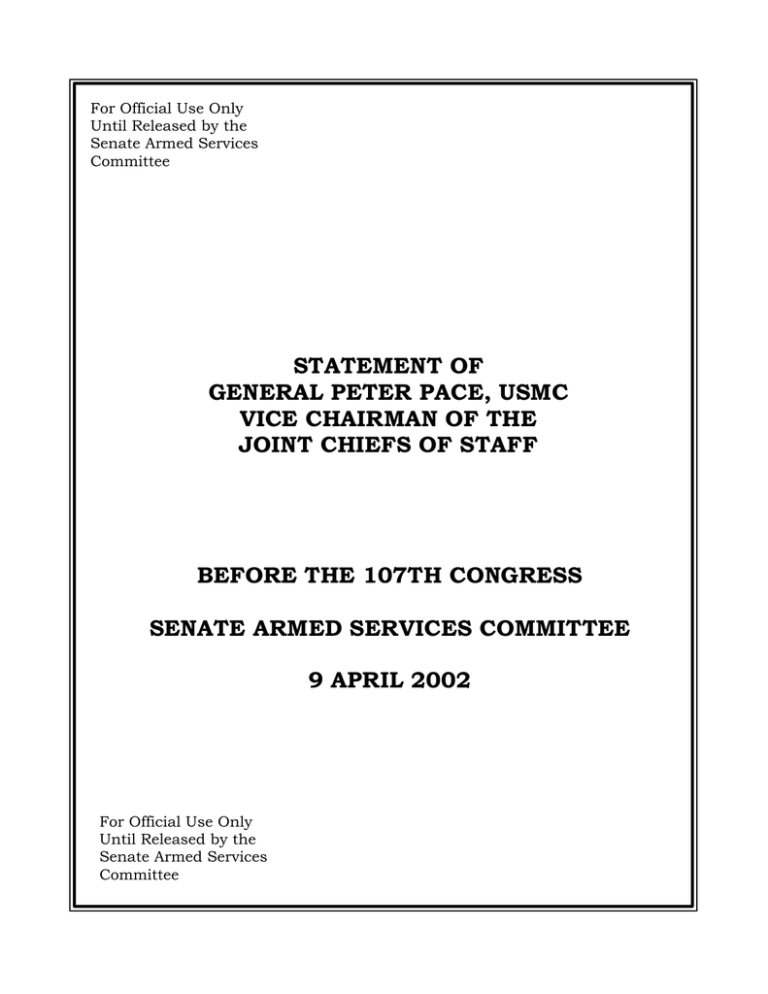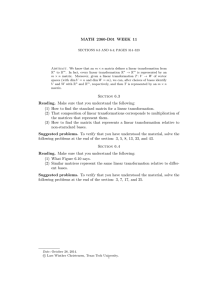STATEMENT OF GENERAL PETER PACE, USMC VICE CHAIRMAN OF THE
advertisement

For Official Use Only Until Released by the Senate Armed Services Committee STATEMENT OF GENERAL PETER PACE, USMC VICE CHAIRMAN OF THE JOINT CHIEFS OF STAFF BEFORE THE 107TH CONGRESS SENATE ARMED SERVICES COMMITTEE 9 APRIL 2002 For Official Use Only Until Released by the Senate Armed Services Committee 1 Introduction Mr. Chairman, thank you for the opportunity to appear before the distinguished members of this Committee. Today is an excellent time to discuss the transformation of America’s Armed Forces as we prosecute the Global War on Terrorism and prepare ourselves to face future threats. We’ve been working the issue of military transformation and welcome the additional emphasis placed on this critical process by the Congress. We must pursue this effort aggressively. I would like to comment on two areas: transformation paths and the transformation process. First, let me provide some context. In his remarks to the cadets at the Citadel this past December, President Bush made defense transformation central to winning the Global War on Terrorism. Subsequently, in January of this year, Secretary Rumsfeld outlined six key transformational goals in a speech at the National Defense University. The goals are: 1) Protect the U.S. homeland and our bases overseas; 2) project and sustain power in distant theaters; 3) deny enemies sanctuary; 4) protect U.S. information networks from attack; 5) use information technology to link up different kinds of U.S. forces so they can fight jointly; and 6) maintain unhindered access to space. Using this framework, General Myers stated that his goal is to foster changes that result in a dramatic improvement over time in the way a combatant commander wages war. We must continually pursue this transformational goal because our enemies will persist in attempts to neutralize or erode our superiority and exploit perceived weaknesses. 2 Transformation is key to finding better ways to perform the fundamental mission of the Armed Forces: fighting and winning our Nation’s wars. Pursuing a methodology to achieve these improvements includes the following key considerations: First, we must base the process for change on an overarching set of capabilities we believe our forces must possess to support our Nation’s security requirements now and in the future. Second, we must develop joint operational concepts and architectures that drive decisions concerning materiel and non-materiel improvements to combat capabilities and to establish standards for interoperability. Third, since transformation involves more than fielding new systems, we must integrate requirements for new Doctrine, Organizations, Training, Materiel, Leadership and education, Personnel, and Facilities (DOTMLPF) into the transformation process. Fourth, we must find ways to modernize and integrate legacy systems when it makes sense. Finally, we must retain the ability to operate in coalitions. Fully exploiting these transformational objectives will require cultural change. This will be as much about “mindset” as it is about anything else. Transformation Paths Transformation is a process, the objectives of which will be achieved on two paths: revolutionary breakthroughs and evolutionary modernization. Both are necessary; both must be underpinned by transformed mindsets. Revolutionary breakthroughs in the past have included new technologies, organizations and doctrine that have led to rapid, dramatic improvements in warfighting capabilities. Technologies and advances hold the potential to 3 revolutionize certain aspects of warfare, profoundly shifting or making previous methods of warfare obsolete. Technologies, such as stealth and satellite surveillance, and organizational developments, such as Napoleon’s use of independent corps formations, are examples of these breakthroughs. Significant transformational change has also been achieved through the cumulative evolutionary effect of modernization efforts. Both paths have the potential to dramatically improve the combatant commander’s ability to wage war, particularly when the capabilities are applied across the joint force through new or innovative combinations. A case in point is the Global Positioning System (GPS). Originally conceived as an improved aid to navigation, GPS was not, in and of itself, transformational. But subsequent modernization efforts with GPS have enabled commanders to synchronize both communications and the movement of forces, as well as enable all-weather precision engagement. Although starting out as a modernization program, GPS has proven to be transformational, vastly improving the joint warfighting capabilities of all our combatant commanders. A significant transformational example is the mindset change fostered by the Goldwater-Nichols Act. Fifteen years after its enactment we have a joint force producing outcomes on the battlefield that would not have been possible had we stayed in our Service-centric approach to warfighting. Whether transformation comes in incremental steps or radical leaps, it must be balanced with the standing requirement to maintain readiness for today’s conflicts and threats. If we only prepare for the future we will find 4 ourselves at risk for today’s threats; if we only prepare for today’s threats we incur huge risks in the future. Thus changes through modernization can provide a hedge against near-term risk, while experimentation can produce the breakthrough developments we must pursue to be properly positioned against future threats. The Transformation Process In the past, transformational efforts – such as the development of strategic bombing, carrier aviation, combined arms warfare and amphibious operations – have been Service-specific. Today we seek to enhance our military capabilities across the joint battlespace. Therefore, transformation requires proactively combining, synchronizing and integrating various transformation efforts. We must ensure that the transformation process is characterized by unity of effort based on clearly defined goals. The Secretary of Defense defines these goals in his Defense Planning Guidance. The Joint Requirements Oversight Council (JROC) plays a critical role in this process. My predecessors put some teeth into the Joint Requirements Oversight Council and made it an engine for joint acquisition. The JROC now has front-end influence to ensure that major weapons systems are “born joint.” With my seat on the Defense Acquisition Board and my role in the budgeting process I can help ensure that all major systems are validated as “joint” before they are procured. We have already had some success with this newer process in program areas such as the Joint Direct Attack Munition and all-weather close air 5 support. But the JROC must move beyond simply grading the Services’ homework. We must examine the Defense Planning Guidance, select specific goals that come properly within our purview, and be the driving force in attaining those specific goals. As I mentioned, experimentation is a key element in the transformation process. We’ve tasked United States Joint Forces Command (USJFCOM) to develop and evaluate joint operational concepts and architectures, conduct and evaluate experiments, recommend legacy system integration, provide feedback from the field, and recommend emerging operational concepts for evaluation. This summer, as a part of this ongoing effort, USJFCOM will conduct the largest joint field experiment to date, called MILLENNIUM CHALLENGE 02 (MC 02). The goals of MC 02 are two-fold: 1) to seek improvements in C4ISR by evaluating several joint warfighting concepts and related tactics, techniques and procedures; 2) to seek improvements in our Armed Forces’ ability to achieve rapid, decisive effects throughout the battlespace. Combatant commands play an important role in the transformation process as well. Although their primary focus is on near-term warfighting, they have the inherent authority and responsibility to submit doctrinal, organizational, training, or other change recommendations. Combatant commands also provide lessons learned from operations and exercises, such as what US Central Command is doing in Afghanistan. These lessons are fed to USJFCOM for evaluation. Finally, combatant commands provide their 6 warfighting requirements to the JROC. In these ways, current and near-term warfighting readiness issues inform the long-term transformation process. The Services organize, train, and equip the force. Their efforts, as guided by the Defense Planning Guidance, will continue to be critical to the transformation process. They will develop and evaluate both Service-specific and joint operational concepts and architectures; support joint concept development with Service experimentation; support joint experimentation; provide feedback from the field; ensure future system development supports validated joint operational concepts and architectures; and also oversee integration of joint DOTMLPF recommendations. The Vice Chiefs of each Service are members of the JROC and are ideally positioned to influence the transformation process. Conclusion Transformation is a process wherein we seek to make dramatic improvements in our warfighting capabilities. Breakthrough changes and modernization changes both contribute to the transformation process. To accomplish military transformation we must articulate goals, harvest ideas, modernize equipment, experiment, and change our mindset. The nation’s security demands that we pursue an aggressive and balanced approach to transformation. Thank you for the opportunity to appear before you and thank you for your consistently strong support of your soldiers, sailors, airmen, and Marines. 7




